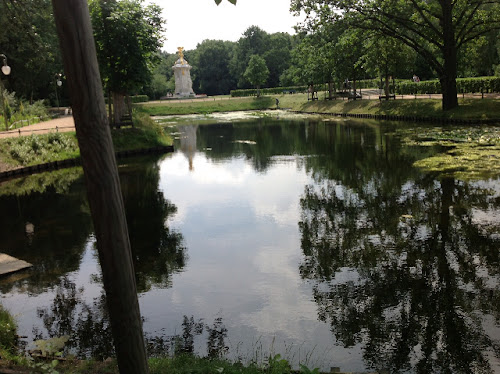It rained and galed for about half my trip to Germany, and, after drought and temperatures that had topped 100 in Ohio, it sometimes felt bone chillingly cold in summery Europe. However, I decided not to be the kind of person who can't function if it's not 70 with clear skies, and so I plunged on, trying to enjoy rain and "cool breezes" after the roasting heat at home.
The afternoon I visited Bonhoeffer's childhood home in the Grunewald neighborhood of Berlin it poured rain in torrents, and I was soaked, a situation not helped by the tendency of wind gusts to flip my umbrella inside out into something resembling a large tulip that the wind tried to pull out of my hand. Then the rain stopped, and as I stood shivering at the bus stop under ominously gray skies, I decided I must find a heavier jacket than the lightweight hoodie I was wearing over a now soaked teeshirt. I happened to ask the elegantly dressed woman standing at the bus stop with me where I could buy a jacket, and she advised I get off at a certain stop on the Kurfurstendam, the grand shopping boulevard that runs east/west across the city.
I must have disembarked at the wrong place, for I found myself walking up the windy, on and off rainy Kurfurstendam looking into dress shops showing a few long wool coats, brocade cocktail dresses and silk blouses hanging in rooms decorated with Louis Quinze furniture, ornate crystal chandliers and plush Oriental carpets. How could I even dream of walking into such showrooms, for such they were, rain bedraggled, in jeans and a hoodie, carrying an oversized purse stuffed with now sodden city maps and a directionally confused umbrella? Instead, I decided to get back on the double decker bus and hop off when I saw an area of stores I could reasonably expect to afford. Soon enough, I found a sports store and in it a serviceable and warm violet jacket for 20 euros, on sale, amid all the 70, 80 and 100 euro and higher thinsulate hiking gear, most with American designer labels.
Later, I was told that the posh stores I eschewed on the Kurfurstendam are for the nouveau-rich wives of rich Russian industrialists and other wealthy foreigners, not ordinary Germans and such mere mortals. I thought of those shops as I read an account of an American, Katherine (Kay) Smith, the wife of an assistant military attache who came to Berlin after the first world war.
As recounted in Andrew Nagorski's Hitlerland, after arriving at the fashionable Adlon Hotel, Kay donned a beige coat with a beige fox collar, beige pumps, beige stockings and a dark blue hat in order to make a rakish entrance onto the streets of Berlin. However, Kay learned not to go out too stylishly dressed after a crowd of shabby Berliners gathered ominously around her and her new clothes, and only “made way for her” when they found out she was an American.
Kay had to deal with a flea-ridden apartment, a city problem, and was shocked when her maid wanted to eat the remains of her husband’s breakfast egg. The maid explained she had not tasted an egg since before the war. When Kay told her to eat all the eggs she wanted, the maid, in turn was shocked—in German households food would be kept under lock and key and the servants weren’t supposed to eat the same food as their employers. Foreigners lived well in Berlin; native Berliners not.
I wondered how the Bonhoeffer family fared in post-war Berlin. I know they suffered a hit during the inflation, though they were shielded from the worst effects by the fact that the father was paid by wealthy clients for psychological counseling in foreign currencies. None of the daughters, all married in the 1920s, set up housekeeping in their mother's prewar style, but at the same time, Dietrich Bonhoeffer would have been one of the fortunate few Germans traveling in the right circles and protected from the worst of the economic hardship facing many in his country. This was not lost on Bonhoeffer, who knew he was insulated from many of life's everyday problems by family money, but who knew too it was wise to finish his university degree and pursue the pastorate. Later, in the short period while he could before the Nazis took over, he worked with other rich Berliners to run programs for poor youth.
The well-heeled Grunewald I saw, row after row of stately houses in a quiet suburb, seemed not much different from what it must when the Bonhoeffers moved there in order to have yard space for a goat and chickens during the "starvation" times of World War I (the grounds surrounding the house were actually rather small). But what was it really like at a time when class divisions were so much sharper, the poor so much poorer, the rich so much richer? What of the threats on the street? I thought of the possible danger the crowd posed to the well-dressed Kay Smith and wondered if it a precursor to anger directed at the Jews. Did Bonhoeffer have to be careful venturing outdoors in his beloved Berlin?
Sent from my iPad



